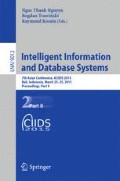Abstract
The medical data and its classification should be particularly treated. The data can not be modified or altered, because this could lead to overestimation or false decisions. Some classifiers, using random factors, can generate false, higher overall accuracy of diagnosis. Medical support systems should be trustworthy and reliable even at the cost of system complexity. In this paper fusion of two classifiers has been proposed, where k–NN classifier and classifier based on a justified granulation paradigm were employed. Additionally, proposed solution allows to visualize obtained classification results. Accuracy of the proposed solution has been compared with various classifiers. All methods presented in this work were tested on real medical data coming from three medical datasets. Finally, some remarks for further research have been proposed.
Access this chapter
Tax calculation will be finalised at checkout
Purchases are for personal use only
Preview
Unable to display preview. Download preview PDF.
References
Foster, K.R., Koprowski, R., Skufca, J.D.: Machine learning, medical diagnosis, and biomedical engineering research - commentary. BioMedical Engineering OnLine 13, 94 (2014)
Song, M., Wang, Y.: Human centricity and information granularity in the agenda of theories and applications of soft computing. Applied Soft Computing (2014). doi:10.1016/j.asoc.2014.04.040
Aha, D., Kibler, D., Albert, M.: Instance-Based Learning Algorithms. Machine Learning 6(1), 37–66 (1991)
Zhang, Y., Zhang, L., Xu, C.: The Property of Different Granule and Granular Methods Based on Quotient Space. Information Granularity, Big Data, and Computational Intelligence Studies in Big Data 8, 171–190 (2015)
Huang, B., Zhuang, Y., Li, H.: Information granulation and uncertainty measures in interval-valued intuitionist fuzzy information systems. European Journal of Operational Research 231, 162–170 (2013)
Kudlacik, P., Porwik, P.: A New Approach To Signature Recognition Using The Fuzzy Method. Pattern Analysis And Applications 17(3), 451–463 (2014)
Cao, Y., Liu, S., Zhang, L., Qin, J., Wang, J., Tang, K.: Prediction of protein structural class with Rough Sets. BMC Bioinformatics 7, 20 (2006)
Pedrycz, W.: Interpretation of clusters in the framework of shadowed sets. Pattern Recognition Letters 26(15), 2439–2449 (2005)
Hirota, K.: Concepts of probabilistic sets. Fuzzy Sets and Systems 5(1), 31–46 (1981)
Mago, V., Morden, H., Fritz, C., Tiankuang, W., Namazi, S., Geranmayeh, P., Chattopadhyay, R., Dabbaghian, V.: Analyzing the impact of social factors on homelessness: a Fuzzy Cognitive Map approach. BMC Medical Informatics and Decision Making 13, 94 (2013)
Emam, K., Dankar, F., Neisa, A., Jonker, E.: Evaluating the risk of patient re-identification from adverse drug event reports. BMC Medical Informatics and Decision Making 13, 114 (2013)
Bernas, M., Placzek, B., Porwik, P., Pamula, T.: Segmentation of vehicle detector data for improved k-nearest neighbours-based traffic flow prediction. IET Intelligent Transport Systems. doi:10.1049/iet-its.2013.0164
Berthold, M., Diamond, J.: Constructive training of probabilistic neural networks. Neurocomputing 19(1–3), 167–183 (1998)
Berthold, M.: Mixed fuzzy rule formation. International Journal of Approximate Reasoning 32(2–3), 67–84 (2003)
Breiman, L.: Random Forests. Machine Learning 45(1), 5–32 (2001)
John, G., Langley, P.: Estimating continuous distributions in Bayesian classifiers. In: Besnard, P., Hanks, S. (eds.) Proceedings of the Eleventh Conference on Uncertainty in Artificial Intelligence, pp. 338–345 (1995)
Pantazi, S.V., Arocha, J.F., Moehr, J.R.: Case-based medical informatics. BMC Medical Informatics and Decision Making 4, 19 (2004)
Pedrycz, W., Gomide, F.: Fuzzy Systems Engineering: Toward Human-Centric Computing. John Wiley, Hoboken (2007)
Aha, D., Kibler, D.: Instance-based prediction of heart-disease presence with the Cleveland database. University of California (1988)
Jossinet, J.: Variability of impedivity in normal and pathological breast tissue. Med. & Biol. Eng. & Comput 34, 346–350 (1996)
Friedman, N., Geiger, D., Goldszmidt, M.: Bayesian Network Classifiers. Machine Learning 29, 131–163 (1997)
Hall, M., Frank, E., Holmes, G., Pfahringer, B., Reutemann, P., Witten, I.: The WEKA Data Mining Software: An Update; SIGKDD Explorations, 11(1) (2009)
Ramana, B.V., Prasad Babu, M., Venkateswarlu, N.: A Critical Study of Selected Classification Algorithms for Liver Disease Diagnosis. International Journal of Database Management Systems (IJDMS) 3(2), 101–114 (2011)
Porwik, P., Doroz, R., Orczyk, T.: The k-NN classifier and self-adaptive Hotelling data reduction technique in handwritten signatures recognition, Pattern Analysis and Applications. doi:10.1007/s10044-014-0419-1
Author information
Authors and Affiliations
Corresponding author
Editor information
Editors and Affiliations
Rights and permissions
Copyright information
© 2015 Springer International Publishing Switzerland
About this paper
Cite this paper
Bernas, M., Orczyk, T., Porwik, P. (2015). Fusion of Granular Computing and \(k\)–NN Classifiers for Medical Data Support System. In: Nguyen, N., Trawiński, B., Kosala, R. (eds) Intelligent Information and Database Systems. ACIIDS 2015. Lecture Notes in Computer Science(), vol 9012. Springer, Cham. https://doi.org/10.1007/978-3-319-15705-4_7
Download citation
DOI: https://doi.org/10.1007/978-3-319-15705-4_7
Published:
Publisher Name: Springer, Cham
Print ISBN: 978-3-319-15704-7
Online ISBN: 978-3-319-15705-4
eBook Packages: Computer ScienceComputer Science (R0)

